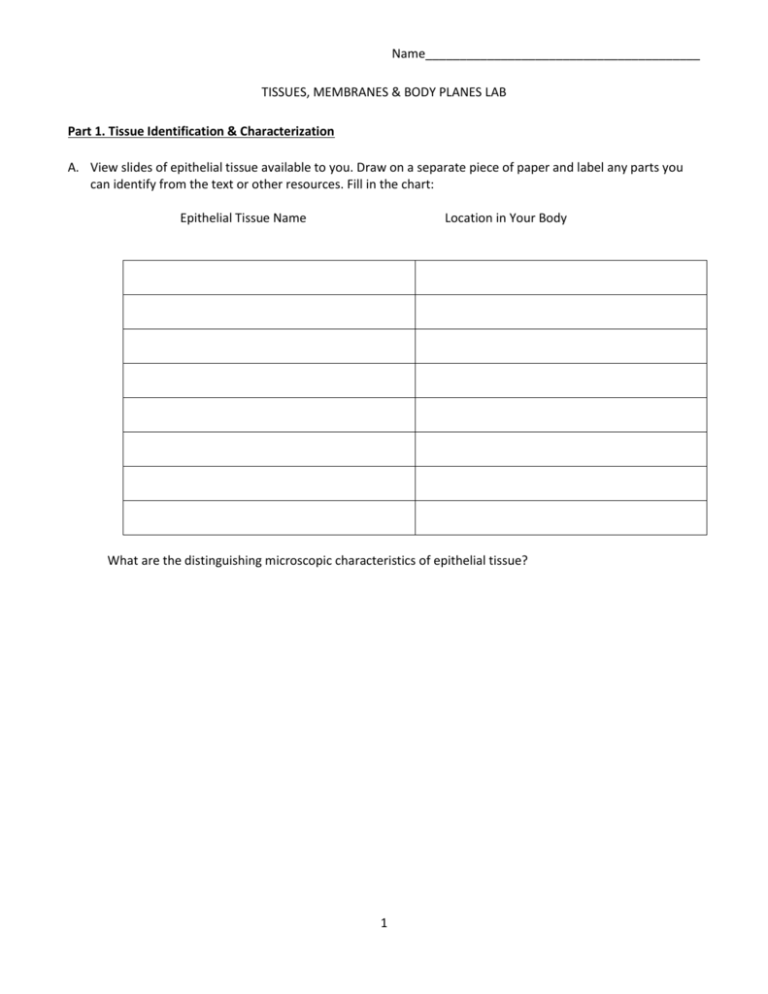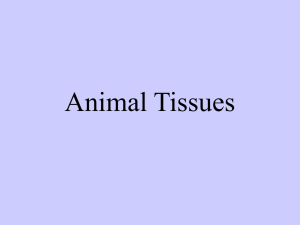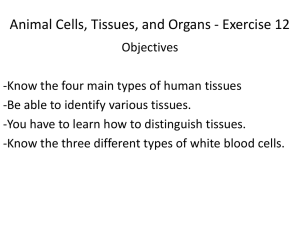Tissues-Membranes-Body-Planes-Lab
advertisement

Name________________________________________ TISSUES, MEMBRANES & BODY PLANES LAB Part 1. Tissue Identification & Characterization A. View slides of epithelial tissue available to you. Draw on a separate piece of paper and label any parts you can identify from the text or other resources. Fill in the chart: Epithelial Tissue Name Location in Your Body What are the distinguishing microscopic characteristics of epithelial tissue? 1 B. View slides of these connective tissue types available to you. Draw on a separate piece of paper and label any parts you can identify from the text or other resource. Fill in the chart: Connective Tissue Name Location in Your Body What are the distinguishing microscopic characteristics of most connective tissue? C. View slides of skeletal muscle, smooth muscle, and cardiac muscle. Draw on a separate piece of paper and label any parts you can identify. 1. Describe the microscopic appearance of the muscle tissues. Skeletal 2 Smooth Cardiac 2. Would adipose tissue have more or less mitochondria than a skeletal muscle? 3. List the four types of special connective tissue. D. View a slide or slides of nervous tissue. Draw on a separate piece of paper and label any parts you can identify. 4. Describe the microscopic appearance of the nervous tissue(s). 5. What are the neuroglial cells and what is their function? 6. How does the structure of a nerve cell match its function? 3 Matching: A. Connective B. Epithelium C. Muscle D. Nervous 1. _____ Forms membranes 2. _____Allows movement of limbs and for organ movements within the body 3. _____ Function is to support cells 4. _____ Function is to communicate 5. _____ Function is to protect and line 6. _____Uses electrochemical signals to carry out its functions 7. _____Supports and reinforces the body organs 8. _____Cells of this tissue may absorb and/or secrete substances 9. _____Basis of the major controlling system of the body 10. ____Its cells shorten to exert force 11. ____Forms endocrine and exocrine glands 12. ____Surrounds and cushions body organs 13. ____Function is to contract and move body 14. ____Characterized by having large amounts of extracellular material 15. ____Allows you to smile, grasp, swim, ski, and throw a ball 16. ____Widely distributed; found in bones, cartilages, and fat deposits 17. ____Forms the brain and spinal cord Underline/circle/highlight the correct answers. 18. A tissue is a. a collection of nuclei b. a collection of organelles c. a collection of cells d. a collection of organs. 4 19. The four major tissue types are a. epithelial b. fat c. connective d. bone e. muscle f. nervous g. blood. 20. The inside of blood vessels is lined with a. cuboidal epithelium b. squamous epithelium c. transitional epithelium d. columnar epithelium. 22. The urinary system is lined with a. cuboidal epithelium b. squamous epithelium c. transitional epithelium d. columnar epithelium 23. Where is simple columnar epithelium found? a. In the kidney tubule b. lining the fallopian tubes c. lining the trachea d. lining the small intestine? 24. Stratified epithelia a. were laid down many centuries ago b. are more important than other tissues c. consist of several layers of cells d. always occur in straight lines. 25. Transitional epithelium allows the a. arteries to expand b. skin to stretch c. uterus to contract d. bladder to stretch. 27. Stratified squamous epithelium does not occur a. lining the stomach b. covering the body c. lining the mouth d. lining the esophagus. 28. The surface cells of stratified squamous epithelium are continually 5 a. b. c. d. dying changing shape being recycled being shed from the surface. 29. Which of the following are not connective tissues a. blood b. tendon c. bone d. saliva e. adipose tissue f. cartilage 30. Which of the following muscle tissues has branched fibers, intercalated discs between adjacent cells and a. contracts automatically b. striated voluntary muscle c. smooth involuntary muscle d. cardiac muscle 31. Which of the following muscle tissues has long fibers and nuclei on the surface? a. striated voluntary muscle b. smooth involuntary muscle c. cardiac muscle 32. Which muscle tissue moves bones? a. striated voluntary muscle b. smooth involuntary muscle c. cardiac muscle. 34. Which muscle tissue is found in blood vessel walls, in the gut wall and in glands a. striated voluntary muscle b. smooth involuntary muscle c. cardiac muscle. 35. Write connective tissue or epithelial tissue next to correct descriptions of these tissues. a. Consists of many cells with little intercellular substance (matrix) ____________________________ b. Penetrated by blood vessels (vascular)_________________ c. Does not cover body surfaces or line passageways and cavities, but is more internally located; binds, supports, and protects _______________________ 36. Match the types of cartilage with the descriptions given. A. Elastic B. Fibrous C. Hyaline 6 a. ____Found where strength and rigidity are needed, as in discs between vertebrae and the symphysis pubis b. ____White, glossy cartilage covering ends of bones (articular), covering ends of ribs (costal), and giving strength to nose, larynx, and trachea c. ____ Provides strength and flexibility, as in external part of the ear 37. Select the types of muscle tissue that best fit the descriptions below. A. Cardiac B. Smooth C. Skeletal a. ____ Tissue forming the walls of the heart. b. ____ Attached to bones c. ____ Spindle-shaped cells with ends tapering to points d. ____ Contain intercalated discs and gap junctions e. ____Found in walls of intestine, urinary bladder, and blood vessels f. ____ Cells are multinucleate Part 2. Body Membranes and Directional Planes Body membranes cover surfaces, line body cavities, and form protective sheets around organs. Body membranes fall into one of two categories; epithelial membranes or connective tissue membranes. There are three types of epithelial membranes, one being cutaneous membranes. Cutaneous membranes form the skin, also known as the integumentary system. The skin serves to protect underlying organs and tissues in the body. In general, we can use the term “membrane” to refer to any thin layer or layers covering or surrounding something. You might be familiar with the term “plasma membrane” as the phospholipid layer surrounding every cell. Now we have tissue membranes consisting of several layers of tissue sandwiched together that surround body cavities, organs, or entire organ systems. 1. Serous membranes a. Practice with a balloon to illustrate this membrane type. b. Describe, draw, and give location. 7 2. Mucous membrane a. Describe, draw, and give location. 3. Synovial membrane a. Describe, draw, and give location. 4. Cutaneous membrane a. Describe, draw, and give location. 8 4. Label the directional planes on the figure below. 9








